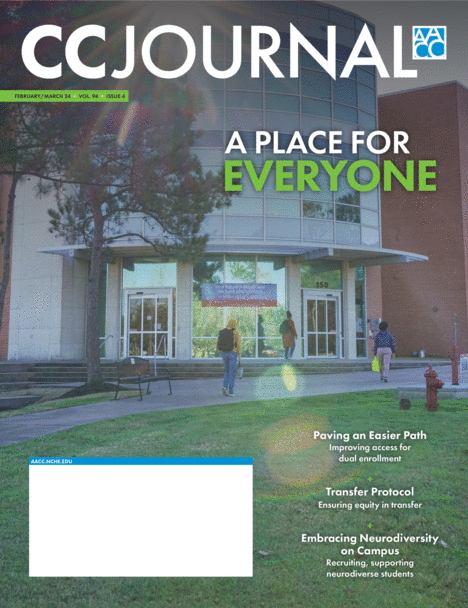When the U.S. Supreme Court ruled in Students for Fair Admissions v. Harvard in June 2023 that race-based affirmative action programs in college admissions processes violated the Equal Protection Clause of the 14th Amendment, some observers worried the decision would hinder the ability of colleges and universities to encourage diversity within their student populations. Others viewed the ruling as an opportunity for community colleges to play an even greater role in ensuring equity among those pursuing a four-year degree.
“Creating a more just higher education system really starts with implementing equitable transfer admissions practices,” says Eleanor Eckerson Peters, director of research and policy at the Institute for Higher Education Policy (IHEP). “Stronger pipelines and partnerships between community colleges and four-year institutions can create avenues for more diverse student bodies.”
This article is an excerpt from the new issue of the Community College Journal, published by the American Association of Community Colleges.
Ahead of the Supreme Court’s decision on the legality of race-based admissions criteria, Massachusetts Gov. Maura Healey and Education Secretary Patrick Tutwiler announced the formation of an Advisory Council for the Advancement of Representation in Education to ensure that Massachusetts would always be inclusive of traditionally underrepresented students, regardless of the high court’s ruling. Acknowledging the critical role that community colleges play in this effort, the 52-person task force includes membership from numerous community colleges, including Massachusetts Bay Community College President David Podell.
“I was so proud of our state,” Podell says. “We moved quickly to engage in this issue.”
The council is scheduled to meet quarterly and will report its recommendations to Healey in August.
Efforts focused on transfer
Angela Sivadon, senior vice president and chief academic officer for Tulsa Community College (TCC), points out that the open-access nature of community colleges in admitting any student makes them important gateways to a four-year degree for students of color.
“If students complete a degree here in good standing, they’re almost guaranteed placement at one of our four-year institutional partners,” she says.
However, transfer equity can’t be taken for granted. Just because community colleges have open admissions policies doesn’t mean students from different demographic groups are graduating and moving on to four-year institutions in equal numbers. Community college leaders should take a hard look at their transfer numbers and identify gaps that must be addressed. Campus leaders need to work closely with their four-year institutional partners to create more equitable transfer opportunities.

“This work is really difficult, and there are a lot of moving parts,” Peters says. “It takes intentionality in evaluating policies and practices to make sure all students can take advantage of transfer pathways. It’s our responsibility to ensure there are supports along that way to help them succeed.”
The American Association of Community Colleges (AACC) was part of a grant program called the Equity Transfer Initiative (ETI) created to help increase transfer rates for Black, Hispanic, adult and first-generation learners. MassBay and TCC are among the community colleges that took part in the initiative. IHEP has its own ongoing initiative, called TransferBOOST, that works with states to increase transfer pathways from two-year to four-year colleges.
Participants in these programs agree that identifying the barriers standing in the way of transferring to a four-year institution, making students aware of transfer opportunities as early as possible, and strengthening relationships with transfer partners are some of the most significant keys to success.
Identify barriers
MassBay participated in ETI along with Framingham State University, its transfer students’ most popular destination.
“We knew from our own data that there were gaps in our student transfers among different racial groups,” Podell says, noting that the college was looking to close those gaps.
One of the most meaningful activities that MassBay did as part of the project was to conduct surveys and focus groups with students who transferred to Framingham State to determine the biggest obstacles they faced in the process. Campus leaders heard repeatedly that transferring to a four-year institution can be a huge culture shock.
“We have to prepare our students better for that,” Podell observes.
For instance, students have to adjust to a new environment with very different expectations.
“At community colleges, students learn how to navigate the college experience,” he explains. “When they move on to a four-year college, their professors aren’t as focused on helping them adjust. We realized that we have to prepare our students to advocate for themselves and ask for help when they need it.”
Better understanding of students’ needs
As Reema Zeineldin, associate vice president of academic affairs for Framingham State, put it, the four-year college experience “can sometimes be like throwing students into the deep end of the pool and expecting them to swim.”
Students who are first-generation college participants are most affected by this culture shift, says Sivadon, observing that they are also the ones who need the most support throughout the transfer process.
“They don’t have someone in their ear who’s been through it before,” she explains. “Students who have someone in their corner tend to be more successful. We’re trying to be that voice for our students.”
TCC has created a transfer checklist so that students know what they need to do at every step in the process. Transfer barriers can include off-campus factors as well, such as mental health, financial hardship and a lack of childcare.
Like many community colleges, TCC offers wraparound support services for its students; for instance, the college has an agreement with the city of Tulsa for its students to ride on city buses for free. However, Sivadon has found that TCC’s four-year institutional partners weren’t as aware of the need for these holistic student supports. In talking with its transfer partners, TCC has stressed the importance of extending these supports to students’ four-year college experience as well.


